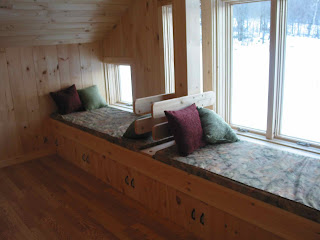Here's the hayloft. Some bedding straw is visible on the left but most of what's here is lovely second cutting hay.
The barn upstairs is so big because it extends out over the run-in/solarium areas on both ends so we decided to put a warm barn office for record storage, chatting with goat/sheep buyers and for waiting out long nights of expectant does or ewes. This barn is a hike up the hill from the house and checking on a mom-to-be every few hours all night would be exhausting. This way I can crash on one of the daybeds along the window and pull my overalls on to walk down the stairs for maternity checks as often as I want without being totally fried the next day. It's a fairly large space so we put some kitchen base cabinets along part of one wall. They have an electric tea kettle, a few utensils and tea in them as well as a wash basin for washing up the tea mugs. I think I'll put a couple cans of soup up there for extra long nights or days during kidding/lambing season. The floor is shiny because it's a fake wood laminate......I much prefer real wood but I couldn't justify the extra expense and this has the benefit of being easy to wipe clean. Under the daybeds is a storage area......who knows what would need storing but it seemed silly to wall off that space with no access.
Here's the same wall of windows/daybeds but the other end of it.
The snack and tea area. The top is just some boards....not sanded or finished but that's okay since this isn't a kitchen....more storage than anything. The file box with all registrations, health charts, breeding notes, etc. is kept in one of these cabinets.
The book shelves and coat rack area......
Notice how my brother used sections of curved birch to make shelf supports. The coat/hat hooks were a gift from my partner Joseph. He made them the year before.
Here is the strip of LED lights that I put up behind the beam to light up the shelf of tea stuff. They adhered perfectly on half of the V-groove of the roof paneling. They cast an amazing amount of warm light.
So, that's it! I think I'm pretty much caught up with barn updates. Hope you've enjoyed them!!!
















